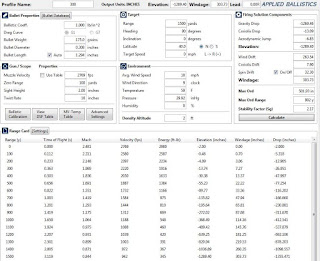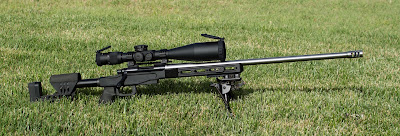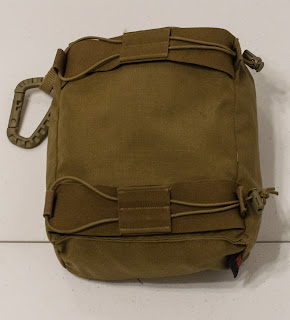6.5 Creedmoor vs 308
This seems to come up a lot so I thought I’d try to make a
comparison for anyone interested.
First, this is really just a comparison of ballistics using
two sets of data. You can change
projectiles and velocities either way, and get different results. I used data from two match rifles that are/were used in practical precision
type matches.
There can be all sorts of criteria a person uses to decide
what they want to shoot. A hunter that
only hunts out a few hundred yards and only takes one shot at a time is likely
to have a different choice than a person setting up a rifle for practical
precision matches that run from 300 yards to 1200 yards, on average. Overall, just pick what fits your need.
One thing that can matter for some uses is the ability to
spot your own shot. When all things are
equal, meaning we use the same weight rifle and both have a good brake, the 6.5
Creedmoor will be easier to spot shots with, as compared to a 308.
Ammo availability, ammo pricing, intended use, what you
already own, barrel life, and all sorts of other criteria might matter to you,
so just think it through and pick what matters most for your use and
preference.
As competitors, some folks shoot with 308 because of the
class they want to shoot in. We see a lot
more of the 6 mm and 6.5 mm calibers/cartridges used overall. I shoot a 6.5 SLR myself and push a 140
Hybrid at 2915 fps. That gives me good
ballistics. I can still get beat at any
match by a better shooter running a 308.
Cartridge and caliber choice matter of course, but the shooter’s ability
also weighs in heavily.
This attempt is more related to ballistics, in an attempt to
remove the shooter from the equation. I
made these charts to show inches, as opposed to showing mil or moa in an
attempt to make it easy for folks to see the difference. You
will find many load variations to compare so if these two aren’t a good
comparison for your use, you can run the numbers the same way on your solver of
choice. As you compare these, consider your target size and your personal use and abilities.
Generally when we make these sorts of choices, we also consider what I like to call 'forgiveness'. So, to make an example a 6.5 Creedmoor can be more forgiving when we don't have everything perfect, such as a wind call or our target distance at 1000 yards. Forgiveness at longer distance is where we start to see some bigger differences and you can use data to decide how much those differences do, or don't, matter to you for your personal use. The bottom charts attempt to make a comparison as related to 'forgiveness'.
This data comes from Applied Ballistics Analytics using
custom curves. This is all at 'sea level' with a 10 mph wind.
6.5 Creedmoor running a 140 Berger Hybrid at 2787 fps
308 running a Sierra TMK at 2769 fps
I'm just going to make three comparisons, but you can refer to the charts to compare any distances you are interested in.
300 yards
6.5 Creedmoor at 300 yards has 13.13" of drop and 5.72" of windage.
308 at 300 yards has 13.74" of drop and 7.27" of windage.
Our difference of drop between the two is .61" with no practical advantage due to normal target sizes or the vital sizes of many animals we hunt.
Our difference of windage between the two is 1.55" with no practical advantage due to normal target sizes or the vital sizes of many animals we hunt.
The 6.5 Creedmoor at 300 yards has 1718 ft-lbs of energy and is traveling at a velocity of 2351 fps.
The 308 at 300 yards has 1916 ft-lbs of energy and is traveling at a velocity of 2220 fps.
Comparing all of the differences and taking into account any possible errors we make in calling our wind or our distance to target, the two are very close at 300 yards.
700 yards
6.5 Creedmoor at 700 yards has 120.40" of drop and 36.36" of windage.
308 at 700 yards has 135.82" of drop and 47.94" of windage.
Our difference of drop between the two is 15.42".
Our difference of windage between the two is 11.58".
The 6.5 Creedmoor at 700 yards has 1038 ft-lbs of energy and is traveling at a velocity of 1827 fps.
The 308 at 700 yards has 975 ft-lbs of energy and is traveling at a velocity of 1584 fps.
1000 yards
6.5 Creedmoor at 1000 yards has 306.63" of drop and 83.25" of windage.
308 at 1000 yards has 368.49" of drop and 114.16" of windage.
Our difference of drop between the two is 61.86".
Our difference of windage between the two is 30.91".
The 6.5 Creedmoor at 1000 yards has 684 ft-lbs of energy and is traveling at a velocity of 1483 fps.
The 308 at 1000 yards has 548 ft-lbs of energy and is traveling at a velocity of 1188 fps.
The next charts also come from Applied Ballistics Analytics, this portion is called WEZ (Weapon Employment Zone).
You can look to the left of the chart to see what is being used as variables. The data you see on the left is comparing the data as if we are off in our calculations by that amount. It also takes into account the accuracy of the firearm and things like our extreme spread. As an example, I entered 1 mph of wind. That means in this example we are off on our wind call by only 1 mph of wind. The hit chance decreases rapidly if I change that number to 2 mph.
I tend to think of the WEZ analysis as my chance of a first round hit. If I'm able to spot my first shot I can then make a correction for the second shot. There are many different ways to look at this data, so use it any way that interests you (or not at all for that matter).
6.5 Creedmoor running a 140 Berger Hybrid at 2787 fps
308 running a Sierra TMK at 2769 fps
List of variables used
Using that list of variables, the first round hit percentage difference is 18.2% difference at 1000 yards.
This is just one simple comparison. You can compare your load or any other specific load data in the same way. None of this is meant to say that anyone is wrong in their personal choice. It's just an attempt to use some data to help in the discussion, for anyone looking for a comparison or looking to make a future choice. There are many factors to consider in a choice, such as rifles chambered in your choice, proper barrel twist rates, ammo pricing, ammo availability, etc.
For factory ammo and factory rifle shooters, the 308 and the 6.5 Creedmoor are comparable in ammo pricing and availability these days. I handload most of my ammo these days and as far as components go, both the 308 and 6.5 Creedmoor are very well supported. Excellent brass, projectiles, and powder choices are available for each.
If factory ammo is the main driver in your choice, then compare what you can buy online. If it matters to you, walk into your local store and see what's available. Where I live, both 6.5 Creedmoor and 308 are easy to purchase, although that doesn't matter much to me.
I hope that helps someone out there and just use whatever criteria matters most to you for your choice.












































